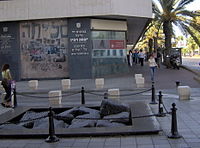Rabin Square



Rabin Square (Hebrew: כיכר רבין, Kikar Rabin), previously Kings of Israel Square (Hebrew: כיכר מלכי ישראל, Kikar Malkhey Yisrael), is the largest open public city square in central Tel Aviv, Israel. It is known for holding many political rallies, parades, and other public events. The square was re-named to 'Rabin square' in 1995, following of the assassination of then Prime Minister, Yitzhak Rabin.
The square is surrounded by the city hall building to the north (designed by the architect Menachem Cohen), Ibn Gabirol Street to the east, Frischmann Street to the south and Hen Boulevard to the west, it was designed alongside the City Hall in 1964 by the architects Yaski and Alexandroni.
History
Until the early 1990s, the square served on Yom Ha'atzmaut, Israel's Independence Day, as a public exhibition ground for IDF field units (mostly tanks and heavy artillery).
At the conclusion of a rally on November 4, 1995, the Prime Minister of Israel, Yitzhak Rabin, was assassinated. In the days following the event, thousands of Israelis gathered on the site to commemorate Rabin. The young people who came to mourn Rabin were dubbed the "Candles Youth" (נוער הנרות, noar hanerot) after the many yahrzeit candles they lit. A segment of the graffiti they drew upon the nearby walls has been preserved.
Today a memorial can be found on the site where Rabin was assassinated (at the northeast corner of the square, below City Hall). Part of the memorial is a small, open legacy wall for the man. Near the north end of the square is a memorial sculpture designed by the Israeli artist Yigal Tumarkin commemorating the Holocaust.
Renovation plans
In the late 1990s and early 2000s there had been criticism about the Square's appearance, and especially about the City Hall building. What in the 1960s was one of the city's biggest and most impressive architectural designs became considered by critics as one of the city's worst eyesores. Plans have been made (most of which have even been approved) to renovate the whole square and City Hall. The plans include giving City Hall a more modern look to fit in with the many new skyscrapers in Tel Aviv, and building a large underground parking complex underneath the square for the neighborhood, which suffers from a dire lack of parking space. Opposition to the renovation plans mostly centers around arguments that the design of the square and City Hall is part of Tel Aviv's history and should be preserved. As a result of this opposition, reconstruction has been delayed.
-
Rabin Square and the Tel Aviv City Hall staircase with a white pixelated heart
